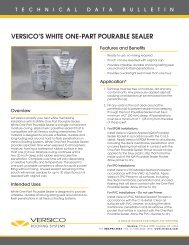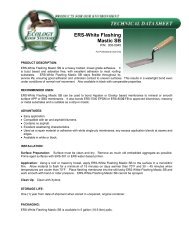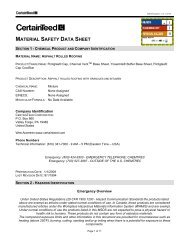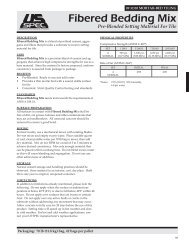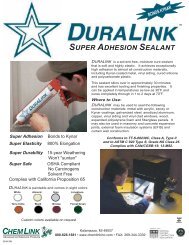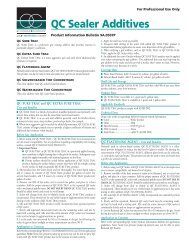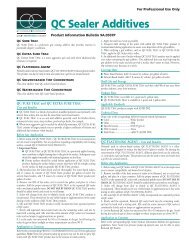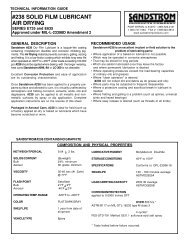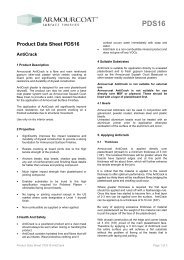Daraweld C - Consumer Information - BuildSite.com
Daraweld C - Consumer Information - BuildSite.com
Daraweld C - Consumer Information - BuildSite.com
You also want an ePaper? Increase the reach of your titles
YUMPU automatically turns print PDFs into web optimized ePapers that Google loves.
J O B A N A L Y Z E R<br />
Product Usage<br />
SOLUTION<br />
PROBLEM<br />
Badly Pitted,<br />
Worn, Broken<br />
Soft, Punky,<br />
Scaly, Friable<br />
Covered with<br />
Grease, Oil,<br />
Foreign Matter<br />
Extremely<br />
Porous<br />
Smooth<br />
and Dense<br />
Newly Placed,<br />
Clean and Sound<br />
DARAWELD ®<br />
Masonry<br />
C<br />
Bonding Agent for Masonry and Concrete Repair<br />
WIRE BRUSH<br />
only in<br />
extreme cases<br />
Application <strong>Information</strong><br />
BONDING AGENT FOR CONCRETE<br />
WASH WITH<br />
DETERGENT<br />
AND RINSE<br />
ACID ETCH<br />
AND<br />
RINSE<br />
PAINT OR<br />
SPRAY WITH<br />
<strong>Daraweld</strong> C<br />
SOAK WITH<br />
WATER<br />
if dry<br />
SCRUB IN<br />
<strong>Daraweld</strong> C<br />
GROUT<br />
LEVEL WITH<br />
GROUT OR<br />
TOPPING MIX<br />
X X X X X X<br />
X X X X X X<br />
X X X X X<br />
X<br />
X<br />
X X X X X<br />
X X X<br />
X X X<br />
With <strong>Daraweld</strong> C, not all concrete surfaces in need of repair have to be chipped or scarified. <strong>Daraweld</strong> C patches can be feather-edged. <strong>Daraweld</strong> C<br />
cuts back on labor and preparation time – yet gives bonded repair – thoroughly dependable through the years of wear, weather, and moisture.<br />
GENERAL REPAIR WORK METHOD MATERIALS<br />
Shallow Patching and Thin Resurfacing<br />
(not more than 1 ⁄2 in. deep) of Worn, Broken,<br />
Scaled or Spalled Concrete Surfaces<br />
Steps, Sidewalks, Driveways, Floors, Walls,<br />
Ramps, Roads, Bridges, Abutments<br />
Bonding Grout for Thick Patches and<br />
Overlays<br />
Same applications as above and to bring<br />
Highway Sections up to Grade<br />
Filling Fine Cracks<br />
Walls, Floors, Pavements, Structures,<br />
Concrete Products<br />
Repairing Wide Cracks<br />
Same applications as above.<br />
Thoroughly pre-mix cement and sand. In a separate<br />
container <strong>com</strong>bine <strong>Daraweld</strong> C with an equal quantity<br />
of water and add to the cement/sand mixture. Mix to a<br />
creamy consistency. Do not overmix. Scrub this bonding<br />
layer onto surface with a stiff bristle brush of corn broom<br />
in a layer no more than 1 ⁄8 in. thick. Level with remaining<br />
material while bonding layer is still soft and plastic.<br />
Follow same method as above for bonding layer. Level<br />
with plain cement mortar or concrete topping and finish<br />
to desired grade. Add air entraining admixture to topping<br />
mix for maximum durability if overlay will be exposed to<br />
freezing and thawing.<br />
Mix materials until blended into thin paste. On horizontal<br />
surfaces, pour paste into crack to overflowing and cut off<br />
with trowel when stiff. On vertical surfaces, paint cracks<br />
with paste, then fill with grout as prescribed above for<br />
Shallow Patching.<br />
Paint crack with straight <strong>Daraweld</strong> C, making sure coating<br />
extends beyond edges. Scrub in grout with stiff brush. Fill<br />
with remaining material and finish with trowel.<br />
*Water content specified for above application is approximate. Add more water where necessary for proper consistency.<br />
1 part <strong>Daraweld</strong> C<br />
5 parts Cement<br />
2 parts Mason’s Sand<br />
1 part Water*<br />
Same materials and<br />
proportions as above.<br />
1 part <strong>Daraweld</strong> C<br />
1 part Cement<br />
1 part Water*<br />
1 part <strong>Daraweld</strong> C<br />
1 part Cement<br />
1.5 parts Mason’s Sand<br />
0.5 part Water*
BONDING APPLICATIONS<br />
Bonding Concrete to Asphalt<br />
Bonding Construction Joints<br />
FLOOR APPLICATIONS<br />
Protecting Floors Against Mild Acid Attack<br />
Laundries, Dairies, Degreasing Pits, etc.<br />
Non-Skid Floor Treatments<br />
Sidewalks, Patios, Garages, Swimming Pools,<br />
Industrial Floors, Aircraft Hangers<br />
Scrub standard <strong>Daraweld</strong> C grout onto asphalt surface<br />
with stiff brush or corn broom. For thick overlay, top with<br />
mortar or concrete topping while grout is still plastic.<br />
When dry, surface can be painted with cement paint.<br />
(See “Painting” section that follows).<br />
When walls or slabs are poured in stages, apply standard<br />
<strong>Daraweld</strong> C grout over the surface of each pour to obtain<br />
integral bond with subsequent pours.<br />
For porous floors exposed to acids, corrosive agents, cleaning<br />
fluids. Bring the mixture to a paint consistency. Apply<br />
with a stiff broom or spray equipment. For best results,<br />
apply at least two coats, allowing 24 hours between coats.<br />
Apply with scrubbing brush, then swirl to get a rough<br />
finish. This application has been extremely successful in<br />
providing safe, sure footing on surfaces normally slippery<br />
when wet.<br />
1 part <strong>Daraweld</strong> C<br />
5 parts Cement<br />
2 parts Mason’s Sand<br />
1 part Water*<br />
Same materials and<br />
proportions as above.<br />
1 part <strong>Daraweld</strong> C<br />
5 parts Lumnite Cement<br />
2.5 parts Portland Cement<br />
1 part Water*<br />
Caution: See Note Below.<br />
1 part <strong>Daraweld</strong> C<br />
5 parts Cement<br />
5 parts Mason’s Sand<br />
1.5 parts Water*<br />
Dustproofing Floors Pour on and distribute evenly with squeegee. Sop up 1 part <strong>Daraweld</strong> C<br />
puddles with cloth or sponge, since a heavy concentration<br />
of the material may seal soft. Floor must be closed to<br />
traffic for 24 hours to allow for thorough drying.<br />
For porous surfaces a second coat is re<strong>com</strong>mended.<br />
2 parts Water*<br />
Leveling for Floor Tile<br />
Before Application of Vinyl and Asphalt Tile<br />
Anchoring Nailing Strips to Concrete Floors<br />
Before Application of Wood Finish Flooring<br />
Layering Plaster Floor Tile<br />
On Wood or Concrete Floors<br />
WALL APPLICATIONS<br />
Apply <strong>Daraweld</strong> C grout and level to desired grade. Allow<br />
24 hours for curing. Apply tile cement directly on new<br />
surface, lay tile.<br />
With straight <strong>Daraweld</strong> C, glue tapered wooden strips,<br />
narrow edge up, to concrete floor. Apply <strong>Daraweld</strong> C<br />
grout between strips and level.<br />
To adhere plaster tile, brush or squeeze <strong>Daraweld</strong> C as<br />
received on wood or concrete surface. Prime with dilute<br />
<strong>Daraweld</strong> C first if surface is dusty and porous concrete.<br />
1 part <strong>Daraweld</strong> C<br />
5 parts Cement<br />
10 parts Mason’s Sand<br />
2 parts Water*<br />
1 part <strong>Daraweld</strong> C<br />
5 parts Cement<br />
10 parts Mason’s Sand<br />
2 parts Water*<br />
Straight <strong>Daraweld</strong> C<br />
Repairing Walls With Gunite Mortar The use of <strong>Daraweld</strong> C increases adhesion of Gunite 1 part <strong>Daraweld</strong> C<br />
applications. When added to the mix water, <strong>Daraweld</strong> C<br />
also tends to decrease rebound during application, and<br />
allows quicker finishing. To mix <strong>Daraweld</strong> C and water,<br />
use a large open drum. Supply gun direct from drum.<br />
1 part Water*<br />
An alternate method is to first spray or brush surface with<br />
a 1:1 solution of <strong>Daraweld</strong> C and water. Apply Gunite<br />
mortar as usual, while bonding coat is still tacky.<br />
Patching Stucco Walls Scrub in <strong>Daraweld</strong> C paste, and level with stucco mortar. 1 part <strong>Daraweld</strong> C<br />
If entire wall is to be resurfaced, scrub in <strong>Daraweld</strong> C 5 parts Cement<br />
grout and apply finish mortar coat while grout is still<br />
tacky. If wall is to be repainted, refer to “Painting” section<br />
which follows.<br />
1 part Water*<br />
Steamproofing Concrete Block Walls<br />
Commercial Laundries, Car Washes,<br />
Poultry Processing Plants, etc.<br />
METHOD MATERIALS<br />
METHOD MATERIALS<br />
METHOD MATERIALS<br />
A two-coat application of <strong>Daraweld</strong> C paste will prevent<br />
steam and water from penetrating concrete block walls<br />
in <strong>com</strong>mercial and industrial processing areas.<br />
Each coat calls for different proportions of materials.<br />
Both applications should be scrubbed on, with a 24-hour<br />
interval between coats.<br />
First coat:<br />
1 part <strong>Daraweld</strong> C<br />
3 parts Cement<br />
3 parts Water*<br />
Second coat:<br />
1 part <strong>Daraweld</strong> C<br />
1 part Cement<br />
1 part Water*<br />
*Water content specified for above application is approximate. Add more water where necessary for proper consistency.<br />
Note: Check setting time of Lumnite-Portland cement <strong>com</strong>bination before making batch. Set may vary from very fast to very slow with<br />
different brands of cement.
MORTAR<br />
Additive for Paving Mortar<br />
PAINTING & FINISHING<br />
<strong>Daraweld</strong> C is widely used as an admixture in mortar for<br />
setting and grouting <strong>com</strong>mon or architectural brick used<br />
for patios, plazas, walkways and similar placements. The<br />
use of <strong>Daraweld</strong> C provides excellent adhesion to the<br />
setting bed and a strong and durable mortar joint. Gray or<br />
white Portland cement with or without mineral oxide<br />
color or prepared masonry cements may be used to effect<br />
matching or contrasting color. Mixed as described, the<br />
mortar (grout) is spread and leveled on the prepared<br />
substrate and the brick set thereon. After the setting bed<br />
has hardened, the joints between the bricks can be filled<br />
with mortar containing <strong>Daraweld</strong> C.<br />
1 part <strong>Daraweld</strong> C<br />
1 part Water*<br />
Cement, lime, sand proportions<br />
to conform to standard<br />
ASTM specifications.<br />
Mix grout, color as desired with mineral oxide. Apply<br />
with stiff brush to 1 Redressing and Coloring Concrete Floors 1 part <strong>Daraweld</strong> C<br />
⁄16 in. thickness, or just thick enough to 5 parts Cement (white)<br />
prevent sand from rolling under trowel. Finish with 2.5 parts Mason’s Sand<br />
steel trowel.<br />
As req. Color<br />
1 part Water*<br />
Finishing Concrete Block Walls Use stiff bristle brush, apply with scrubbing action. 1 part <strong>Daraweld</strong> C<br />
Increasing the <strong>Daraweld</strong> C content in the mix will give a 5 parts Cement<br />
dense, semigloss texture that can be colored or painted. 10 parts Mason’s Sand<br />
One coat is sufficient except where severe water seepage<br />
occurs. (See “Waterproofing” section that follows.)<br />
2 parts Water*<br />
Painting Concrete Blocks, Brick or Sandstone Mix dry and wet ingredients separately. Add dry mixture to 1 part <strong>Daraweld</strong> C<br />
liquid to get paint consistency. Add color for desired color. 5 parts Cement<br />
Proper proportions of gray and white Portland cement will 10 parts Mason’s Sand<br />
give matching color for concrete blocks. Apply with 2 parts Water*<br />
scrubbing action. Caution: Do not attempt to apply cement<br />
paint over earlier coat of oil paint.<br />
As req. Color<br />
Striping Asphalt Surfaces The addition of <strong>Daraweld</strong> C to white cement mortar 1 part <strong>Daraweld</strong> C<br />
produces a highly durable striping material. Mix dry 5 parts Cement (white)<br />
and wet ingredients separately. Combine mixtures just 2.5 parts Mason’s Sand<br />
before application. Scrub onto clean asphalt surface. 1 part Water*<br />
As req. Color<br />
SPECIAL APPLICATIONS<br />
Repairing and Making Special Joints in<br />
Concrete Pipe<br />
Preventing Corrosion and Seepage of<br />
Concrete Pipe<br />
<strong>Daraweld</strong> C can be used to patch broken or specially<br />
sectioned pipe at the casting plant and in the field. Mix and<br />
scrub thin paste, nesting the broken sections together until<br />
paste is cured. Small breaks and/or cracks can be filled with<br />
this same paste mix, with 2 parts mason’s sand added.<br />
<strong>Daraweld</strong> C’s acid-alkali resistance makes it an excellent<br />
protective <strong>com</strong>pound. It was successfully used to stop<br />
seepage of corrosive waste through concrete pipe at the<br />
Atomic Energy Commission installation at Oak Ridge,<br />
Tennessee.<br />
1 part <strong>Daraweld</strong> C<br />
5 parts Cement<br />
1 part Water*<br />
1 part <strong>Daraweld</strong> C<br />
3 parts Lumnite Cement<br />
6 parts Mason’s Sand<br />
1 part Water*<br />
Caution: See Note Page 2.<br />
<strong>Daraweld</strong> C is ideal for repairing the holes created by<br />
removal of test specimens. Core test holes of 5 in. diameter,<br />
repave, with a 17 Plugging Core Test Holes Add 20% <strong>Daraweld</strong> C by<br />
weight of specified cement.<br />
⁄8 in. <strong>Daraweld</strong> C patch, showed no break Reduce water equal to vol-<br />
in the bond after 50 cycles of freezing and thawing. ume of <strong>Daraweld</strong> C added.<br />
Scrub on <strong>Daraweld</strong> C mixture. A patch in the form of a<br />
band of belt approximately 3 ft wide and 1 Repairing Leaking Construction Joints 1 part <strong>Daraweld</strong> C<br />
⁄4 in. thick has 3 parts Cement<br />
worked especially well around leaking construction joints 1.5 parts Mason’s Sand<br />
in concrete tanks.<br />
0.5 part Water*<br />
Reclaiming Prestressed Concrete Prestressed concrete slabs and beams damaged during 1 part <strong>Daraweld</strong> C<br />
handling or by other causes (fire included) can be repaired 5 parts Cement<br />
with <strong>Daraweld</strong> C. Just scrub on standard <strong>Daraweld</strong> C 2 parts Mason’s Sand<br />
grout. If necessary, trowel on a thicker coat at cracks,<br />
corners or surface indentations. <strong>Daraweld</strong> C can be used<br />
to fill holes for eyebolts or hooks attached on the site.<br />
1 part Water*<br />
WATERPROOFING<br />
Waterproofing Coating<br />
Exterior Masonry Above and Below Grade,<br />
Cellar Floors, Machinery Pits, Ceramic Wash<br />
Basins, etc.<br />
METHOD MATERIALS<br />
METHOD MATERIALS<br />
METHOD MATERIALS<br />
METHOD MATERIALS<br />
Two or three coats of <strong>Daraweld</strong> C grout are required<br />
for successful waterproofing applications. Mix materials<br />
to brushable consistency. Scrub each coat into surface<br />
with stiff brush. Apply second and third coats at 24-hour<br />
intervals. To stop water seepage through cellar floors,<br />
machinery pits, etc., install a sump pit to drain off standing<br />
water. Repair bad spots with hot patches. Sop up all<br />
puddles before applying grout.<br />
*Water content specified for above application is approximate. Add more water where necessary for proper consistency.<br />
1 part <strong>Daraweld</strong> C<br />
3 parts Cement<br />
6 parts Mason’s Sand<br />
1 part Water*
Mixing Grout<br />
Thoroughly pre-mix cement and fine<br />
mason’s sand. In a separate container<br />
<strong>com</strong>bine <strong>Daraweld</strong> C with a re<strong>com</strong>mended<br />
quantity of water and add to<br />
the cement-sand mixture. Even when<br />
the grout is machine-mixed, which we<br />
re<strong>com</strong>mend, the dry and wet ingredients<br />
should be mixed separately.<br />
<strong>Daraweld</strong> C grout should have the<br />
consistency of heavy cream. Do not<br />
overmix, or whip air into the grout.<br />
Overmixing can cause blistering in<br />
surface coatings. Mix until ingredients<br />
appear to be normally blended.<br />
Use enough <strong>Daraweld</strong> C in plastic<br />
mix. Quantities smaller than specified<br />
will lessen bond strength.<br />
Make up in small batches. <strong>Daraweld</strong> C<br />
grout will stiffen and be<strong>com</strong>e hard to<br />
apply within 30 to 40 minutes after<br />
mixing. Make up only what you can<br />
use in this period. Do not retemper.<br />
Applying Grout<br />
Scrub <strong>Daraweld</strong> C bonding grout<br />
onto surface with a stiff bristle brush<br />
or broom in a layer not more than<br />
1 ⁄8 in. thick. Work briskly to break<br />
through surface tensions and<br />
entrained air. In thin patches less than<br />
1 ⁄2 in. deep, level with <strong>Daraweld</strong> C<br />
grout while bonding layer is still soft<br />
and plastic.<br />
Topping Mixes<br />
Visit our web site at: www.graceconstruction.<strong>com</strong> printed on recycled paper<br />
W. R. Grace & Co. - Conn., 7221 West Parkland Court, Milwaukee, WI 53223 Tel: (414) 354-4400 Fax: (414) 354-5088<br />
DARAWELD C, DAREX AEA and DARAVAIR are registered trademarks of W. R. Grace & Co. - Conn.<br />
Limit the amount of water used in<br />
topping mixes. A dry, low water<br />
content mix will result in a dense,<br />
hard floor surface.<br />
Use maximum-size aggregate<br />
consistent with depth of overlay.<br />
Apply and level topping material<br />
while <strong>Daraweld</strong> C bonding layer is<br />
still soft and plastic.<br />
Topping should be dry enough to<br />
require considerable tamping for <strong>com</strong>paction.<br />
The tamping will also provide<br />
better intimate contact between the<br />
bonding grout and the topping. Screed<br />
a little high for <strong>com</strong>paction.<br />
Don’t forget that straight Portland<br />
cement mortar or concrete toppings<br />
exposed to freezing and thawing<br />
should be properly air entrained<br />
with Darex AEA ® or Daravair ® .<br />
No entrained air is required for the<br />
<strong>Daraweld</strong> C bonding grout.<br />
Finishing<br />
In thin resurfacing work, wood<br />
floating immediately after screeding<br />
will make for a stronger bond and<br />
minimum shrinkage.<br />
For a smooth surface, a single pass<br />
with a steel trowel is re<strong>com</strong>mended.<br />
Do not overfinish. Excessive steel<br />
troweling will cause desiccation,<br />
or drying-out.<br />
The tamped topping mixes used in<br />
thicker overlays can be finished<br />
normally.<br />
We hope the information here will be helpful. It is based on data and knowledge considered to be true and accurate and is offered for the users’ consideration,<br />
investigation and verification, but we do not warrant the results to be obtained. Please read all statements, re<strong>com</strong>mendations or suggestions in conjunction with our<br />
conditions of sale, which apply to all goods supplied by us. No statement, re<strong>com</strong>mendation or suggestion is intended for any use which would infringe any patent or<br />
copyright. W. R. Grace & Co. - Conn., 62 Whittemore Avenue, Cambridge, MA 02140. In Canada, Grace Canada, Inc., 294 Clements Road West, Ajax, Ontario,<br />
Canada L1S 3C6.<br />
This product(s) may be covered by patents or patents pending. Copyright 2001. W. R. Grace & Co. - Conn. MP-054B Printed in USA 12/01 FA/GPS/3M<br />
Hydration and Curing<br />
The patch area must be damp.<br />
A too-dry surface will draw water<br />
out of the grout too swiftly to allow<br />
proper hydration of the cement.<br />
Excessive troweling or finishing on<br />
thin patches or overlays will prevent<br />
proper curing.<br />
Proper curing of the new patch or<br />
overlay will greatly improve its<br />
<strong>com</strong>pressive strength and abrasion<br />
resistance, and will prevent excessive<br />
shrinkage.<br />
Surface Cleaning<br />
Oil and grease should be removed by<br />
washing with a strong solution. Sand<br />
blasting and water blasting, chipping<br />
or scarification have been found to<br />
be acceptable methods to remove<br />
unsound surface mortar. A thorough<br />
rinse with clear water prior to the<br />
application of the <strong>Daraweld</strong> C bonding<br />
grout is re<strong>com</strong>mended. If muriatic<br />
acid is used to remove unsound<br />
surface mortar, before applying the<br />
<strong>Daraweld</strong> C overlay the area must be<br />
thoroughly rinsed with clear water<br />
to remove all of the acid. Safety<br />
procedures as re<strong>com</strong>mended by the<br />
manufacturer of the acid should be<br />
strictly adhered to.



